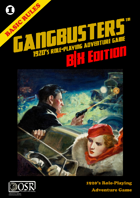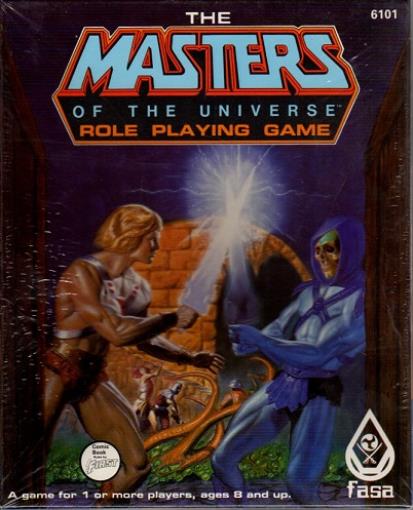Gang Busters B/X Edition 1920's Role-playing Adventure Game
by Mark A. Hunt, copyright 2019
Where to buy: https://www.drivethrurpg.com
The Good, The Bad, and The Ugly:
Gangbusters B/X Edition (GBBX) is a B/X reworking of TSR's 1982 Gangbusters RPG. A player who has played the 1981 version of Dungeons & Dragons, or one of its many OSR clones will be able to play GBBX with minimal effort. The rulebook, more or less, follows the same layout as original BX D&D.
What is called the Dungeon Master in D&D is here called the Judge, Gamemaster, Referee, or Ward Boss.
The book lays out a handful of campaign types, criminal, detective, law enforcement, reporter, or strange mysteries. I imagine that a campaign would work really well with a combination of the above. Having one player a G-Man and another a gangster probably would not work out that well in the long run, but having one player as an undercover agent could be all sorts of fun for a one-shot or short campaign.
Character creation is nearly identical to normal D&D and this game uses the same ability scores and bonus/penalty scheme. The classes available are the Brutish, Connected, Educated, and Street Smart. My first annoyance with the rules is on page GB10, where the hit dice are reversed for the Educated and Street Smart - the character creation example in this chapter has the correct hit dice. Characters top out at 6th level, as opposed to 14th in standard BX D&D. This could be a good thing or a bad thing, depending on what sort of campaign the players want. I think it is a good thing.
Each class has certain special abilities. Some examples are the Brutes, who don't suffer the standard -4 penalty to attack rolls for improvised weapons at 2nd level and the Educated, who pick areas of expertise.
GBBX does use alignment but it is basically how law-abiding the characters are. I feel that this could probably have been left out of the game; however, I understand that it is included to remain compatible with BX D&D. Character type could also have been left out and left to simple roleplaying. Character types include options such as assimilated, city slicker, immigrant, and troublemaker.
This game uses "the common tongue" for the primary spoken language. It could easily have been called English, since this is exactly what the "common tongue" is. The language chart also should have been adjusted for actually spoken 1920s languages common in the USA. According to the rules, with a random roll, there is a 5% chance of speaking German or Spanish but a 10% chance of speaking Hindi. This is just an odd choice. The author is presumably trying to match the 1d20 language table from BX.
My third gripe is the way Armor Class is figured. If the character wears a 3-piece suit, he will be AC 3 (16 ascending, in more modern games), while wearing farmer's overalls gives an AC of 7 (12 ascending). This, to me, is a mind-bogglingly bad decision. If I ever run this game, all characters will be AC 9 (10 ascending), regardless of clothing, with a bonus for a bullet proof vest or a parka, maybe.
After character creation, we get into the meat of the rules. The game does a really good job of detailing the life of an adventurer in the 1920s, including crime, stolen goods, police patrols, street gangs, retainers (see below on an issue with this), and starting a legitimate (or not) business. The Competition saving throw is a really elegant way of determining how much money a business can make and avoids the minutia of counting dimes and nickles.
Retainers is an issue. The Charisma ability score gives the maximum number of retainers allowed per character but the "Starting a Gang" chapter totally ignores this. Assuming I understand the mechanic here, a retainer costs a number of "Influence Points" and the maximum number equals the character's Charisma score. I think that I like this way of doing it more but if this is how the rules are supposed to work; the Charisma "Max number of retainers" should have been left out - again, assuming I am reading this correctly. Unless, of course, the Influence Points is counted up and compared to the Maximum number of retainers? The rules are pretty unclear. Recruiting a thug costs .5 Influence while a femme fatale costs 3, for those who are interested.
There is a sample city included for those who do not want to base the game in a real city. It is called Rock Junction and is near Lake Michigan.
The Building Adventures chapter also includes some nice random charts.
Investigations is an interesting chapter and includes this game's version of the Turn Undead table, which is used for roughing up and threatening NPCs. A level 1 character cannot convincingly threaten a real gangster or G-Man. I think using the NPC reaction or retainer table would make more sense but it is amusing to use a version the Turn Undead table.
NPCs, trials, witnesses, law enforcement resources, and encounters come next and are basically what you would expect. All of it is good information. You can tell that Mr. Hunt did his homework.
Vehicle combat gets its own chapter, which is appropriate for a game where gangsters can ride along on running boards with Tommy guns.
Adversaries gets a chapter, of course, and includes some era standards - mobs, sheriffs, moonshiners, gangsters, etc. There is a small section on Creatures of the Night for those who want to have the supernatural in their games. I would love to see this fleshed out with its own chapter - perhaps move all of the fantasy options to an appendix.
Morale and combat work exactly the same as traditional BX D&D. Guns have special rules for bursts, sprays, unloading with both barrels of a shotty, cover, etc. Variable weapon damage is mentioned, but since the weapon tables shown previously don't mention that all weapons do d6 damage and instead have the "variable damage" listed, it is pretty silly. I feel that the optional rule should be for all weapons to do d6 rather than the variable, which anyone reading the book in order will have assumed is how it works. Players choosing to be "shot in the arm" is a pretty neat optional rule. With this, players can have their characters take a penalty to attack rolls and movement in order to not lose hit points.
Healing is a bit better than standard D&D since medical care is more advanced than in fantasy land.
Saving throws work as you would expect but the saving throws are: moxie (grit, willpower, etc.), quickness, toughness, driving (this seems odd but I think it works), and observation. Interestingly, Wisdom, which the rules note includes perception, modifies moxie but not observation. I understand that willpower is a part of Wisdom and I assume that Mr. Hunt did not want Wisdom to be overly useful for saving throws. If/when I run this, I might change this up a bit.
The rulebook ends with a page on Mysterious Powers (think the Shadow or the Phantom) and a page of inspirational bibliography. There is also a standard character sheet, as most games include.
Included in the 64 pages are all that is needed for a 1920s campaign. I would have loved to have seen a more detailed setting - say 10 to 12, or more, pages of the sample city, region, NPCs, and a sample adventure that can be used for one or two of the campaign types. A sample city map would be nice.
One thing to note is that this game is riddled with typographical and capitalization errors. The book specifies two individuals were proof readers and I would love to have these two gentlemen spend more time on this. In one particular paragraph on page GB24, I count 2-3 missing commas and maybe an "and" or a semi-colon.
⇒Grit:
★★★★★ All of the rules you will need are here. I would have liked an extra page or two of supernatural content but since this game is trying to be a standard Roaring 20s game, I won't ding it.
⇒Vigor: ★★★☆☆
The game would probably work, as is, but with another 10 or 12 pages of setting info, perhaps a timeline of the 1920s including some tie-ins between the timeline and the sample setting, I think this game could easily be 4 or 5 stars. As it stands, the Judge is going to have to do quite a bit of research on the 20s to make the game believable.
⇒Grace: ★★★☆☆ The rulebook has a nearly perfect layout - as did the game on which this is based. With some more art and far, far fewer typos and missing commas, and consistently using bullet points (pick all small or all large!) and tabbing indents, it would be 4 stars for sure. The Sequence of Events table on page GB55 causes my soul to ache.




